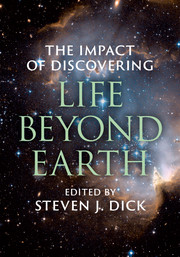Book contents
- Frontmatter
- Dedication
- Contents
- List of contributors
- Introduction: Astrobiology and society
- Part I Motivations and approaches: How do we frame the problems of discovery and impact?
- Part II Transcending anthropocentrism: How do we move beyond our own preconceptions of life, intelligence, and culture?
- 5 The landscape of life
- 6 The landscape of intelligence
- 7 Universal biology: assessing universality from a single example
- 8 Equating culture, civilization, and moral development in imagining extraterrestrial intelligence: anthropocentric assumptions?
- 9 Communicating with the other: Infinity, geometry, and universal math and science
- Part III Philosophical, theological, and moral impact: How do we comprehend the cultural challenges raised by discovery?
- Part IV Practical considerations: how should society prepare for discovery – and non-discovery?
- Contributor biographies
- Index
- References
9 - Communicating with the other: Infinity, geometry, and universal math and science
from Part II - Transcending anthropocentrism: How do we move beyond our own preconceptions of life, intelligence, and culture?
Published online by Cambridge University Press: 05 November 2015
- Frontmatter
- Dedication
- Contents
- List of contributors
- Introduction: Astrobiology and society
- Part I Motivations and approaches: How do we frame the problems of discovery and impact?
- Part II Transcending anthropocentrism: How do we move beyond our own preconceptions of life, intelligence, and culture?
- 5 The landscape of life
- 6 The landscape of intelligence
- 7 Universal biology: assessing universality from a single example
- 8 Equating culture, civilization, and moral development in imagining extraterrestrial intelligence: anthropocentric assumptions?
- 9 Communicating with the other: Infinity, geometry, and universal math and science
- Part III Philosophical, theological, and moral impact: How do we comprehend the cultural challenges raised by discovery?
- Part IV Practical considerations: how should society prepare for discovery – and non-discovery?
- Contributor biographies
- Index
- References
Summary
If the search for extraterrestrial intelligence (SETI) detects an artificial signal from a distant civilization, our next challenge will be to understand any encoded message, and then to decide what we may want to transmit in reply. The few intentional messages humans have sent into space thus far reflect the assumption that mathematics and science are universal. Any civilization able to build technology capable of interstellar communication must certainly know at least the basics of these areas, it is often argued. How accurate is this Platonic notion that our math and physics tap into universal principles? Might different civilizations have their own versions of math and science that are perfectly adequate for explaining the universe, but that do not directly map onto our notions?
Lingua Cosmica
In the standard approach to constructing interstellar messages that may be comprehensible to an independently evolved intelligence, we start with concepts presumably shared by sender and recipient. If the goal of interstellar communication is to share information not previously known by the recipient, the sender has the additional challenge of identifying a sequence that will lead from shared to unique information. For example, logician Hans Freudenthal began his interstellar language Lingua Cosmica, or Lincos, with an exposition of mathematical concepts (Freudenthal 1960). He then moved to a discussion of time; then human behavior; and finally notions of space, motion, and mass. In the process, he attempted to convey some of the idiosyncrasies of human life in terms of potentially universal principles of mathematics and science.
A recurrent critique of Lincos is that ambiguities at one point in the exposition may make subsequent sections unintelligible. In this chapter, I examine the potential problems raised by Freudenthal's reliance on concepts related to infinity early in his message, and propose an alternative approach that introduces notions of three-dimensional (3D) space and motion as a foundation for discussing human behavior, with the goal of enhancing intelligibility.
- Type
- Chapter
- Information
- The Impact of Discovering Life beyond Earth , pp. 143 - 154Publisher: Cambridge University PressPrint publication year: 2015
References
- 1
- Cited by



